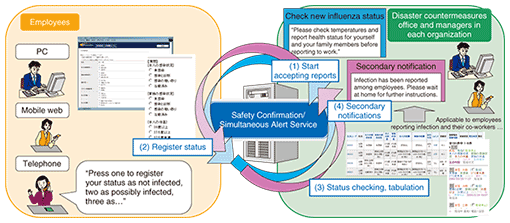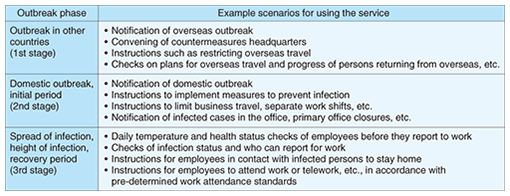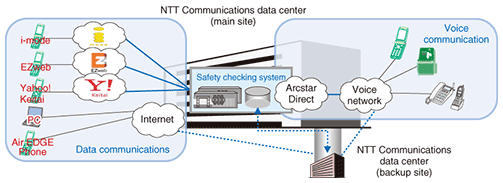 |
|||
|
|
|||
|
Special Feature: ICT-based Risk Management and Business Continuity Management Vol. 8, No. 1, pp. 12–16, Jan. 2010. https://doi.org/10.53829/ntr201001sf2 Functions for Countermeasures against New Influenza Strain in MobileConnect Safety Confirmation/Simultaneous Alert ServiceAbstractThe MobileConnect Safety Confirmation/Simultaneous Alert Service can communicate company information during every phase of a disease outbreak. It strengthens abilities to check the health status of employees, which has recently become a growing concern in light of threats that could inflict serious damage on the economic activity of industry and society, including the risk of wide-spread infection by new strains of influenza such as Swine Flu, in addition to natural disasters such as earthquakes.
1. IntroductionThreats that could cause serious damage to the economic activity of enterprises and society include artificial disasters such as terrorism and natural disasters such as earthquakes. Recently, the increasing risk of a global pandemic due to infection from new strains of influenza or other contagions has raised concern. Business continuity plans (BCPs), which include countermeasures against risks of these types, are becoming an urgent issue. The World Health Organization has recently declared the spread of the H1N1 strain of influenza, which broke out in April 2009 (Swine Flu) to be a Phase 6 pandemic. Furthermore, Japan’s Ministry of Health, Labor and Welfare has declared the spread of the new influenza in Japan to be at the initial outbreak stage. As of June 2009, the virus is relatively weak and expected to have limited effect on economic activities in society and enterprises, but our inability to predict the timing or location of possible additional new H1N1 strains and the speed with which these infections could spread to the global scale has once again been demonstrated. 2. Enterprise countermeasures against new influenza strainsWhen there is an outbreak of a new influenza strain, enterprises need to check on the health and safety of their employees and their families and take measures to ensure the continuity of their businesses. The spread of a new virus to employees or their families could force an enterprise to reduce or suspend its business, so it must take measures to ensure the continuity of critical tasks in such cases. If appropriate measures are not taken, there is the additional risk that the infection could spread not only within the company, but throughout society as well, so companies also have a corporate social responsibility to take appropriate measures. Countermeasures against new strains of influenza within enterprises include mainly: (1) consolidating an emergency-management structure, (2) taking measures to prevent the spread of infection, (3) executing the BCP, and (4) implementing education and training. (1) To consolidate an emergency-management structure, enterprises must create an emergency management scheme for the top managers who will execute measures to prevent the spread of infection and form a decision-making structure for business continuity. Enterprises must also consult with related companies and establish information sharing systems to preserve supply chains. (2) To take measures for preventing the spread of infection, enterprises must strictly enforce instructions such as wearing masks, washing hands, and gargling among employees; restrict entry to the workplace; and perform additional cleaning and disinfection. They must also check the state of health of employees and their families to determine who is infected or at risk of infection. (3) A BCP designed to handle an influenza outbreak includes different elements than a plan for earthquakes, so these different characteristics must be taken into consideration (Table 1). The basic approach for earthquake BCPs is to identify critical tasks and prevent their interruption while recovering as quickly as possible. On the other hand, with new strains of influenza, the required level of business continuity must be decided, taking into consideration the infection risk, responsibility to society, and management issues. The effects could be national or global, so options such as completing work by using alternative facilities or coordinating with trading partners could be difficult, and the affected timeframe could potentially be long. Thus, a BCP for coping with the outbreak of a new influenza strain must identify critical tasks during each stage of the outbreak and treat them with measures such as employee substitutions, shift working, and teleworking.
(4) Every employee in an enterprise must undergo education and training to gain appropriate knowledge about the new strains of influenza, measures to prevent infection, and the details of the BCP to ensure that the BCP is executed smoothly. 3. MobileConnect Safety Confirmation/Simultaneous Alert ServiceThe MobileConnect Safety Confirmation/Simultaneous Alert Service provided by NTT has the following functions to support enterprise countermeasures against new strains of influenza (Fig. 1 and Table 2).
3.1 Functions(1) Broadcast Notification function When a new strain of influenza breaks out, an enterprise must obtain accurate information about the stages of the outbreak domestically and internationally and must direct employee activities accordingly as quickly as possible, including implementing comprehensive measures to prevent infection, restricting travel to infected areas, and instituting shift schedules and teleworking. For example, if a person in the workplace is confirmed to have the infection, that information must be shared with other employees promptly and measures, such as closing the workplace, instructing persons who were in close contact to stay at home, and monitoring their progress, must be taken to minimize the impact of the infection. Moreover, since new strains of influenza can affect the entire country, many employees in widespread locations may need to be contacted and managed. The Broadcast Notification function supports the smooth transmission of information and instructions to these employees. It allows managers to register messages and questions for employees on the administration page, which the system then sends to preregistered employee (mobile) phone numbers and email addresses. The system automatically resends the information to employees until they confirm receiving it by phone, personal computer (PC), or a web-capable mobile device. They can also reply to questions or enter comments for the company at the same time. The administration pages also support both PC and mobile web formats, so administrators can contact employees and check their situation at any time, including when they are at home or away from the office. (2) New influenza Status Checking function During the expansion period and at the height of a new influenza outbreak, it is estimated that work absence will range from 20% to 40% due to infection of employees and their family members. To prevent the spread of infection and for business continuity, enterprises need to gather reports from all employees about the health conditions of themselves and their families before they report for work each day, including information such as whether anyone has a fever and whether they can attend work. The New Influenza Status Checking function supports this daily check of the health and infection status of employees and their families. It allows employees to answer any questions configured by the administrator using their PC, mobile phone, or mobile web device and to send other messages to the company. Unregistered employees can be sent a request to register by the administrator. The system also allows the administrator to configure the start and end of the registration process, which is then executed automatically by the system, reducing the workload for administrating daily status checking. These processes can be configured by date and time as well as in other formats such as setting by time period or day of the week. Furthermore, with new strains of influenza, unlike other disasters such as earthquakes, the details that need to be checked for each employee change according to the progression of outbreak phases. The New Influenza Status Checking function lets the administrator edit requests on the administration page, so status checking can be adjusted flexibly as the outbreak progresses through its phases and as the company situation changes. (3) Secondary Notification function Employees who have been infected or are at risk of infection must be instructed to stay at home in order to prevent the spread of infection. In addition to the infected persons, it may also be necessary to check in detail the health of those who may have been in close contact with them or instruct the infected persons as quickly as possible to stay home. In addition, employees able to report to work must be identified, and individual requests to report for work or instructions for teleworking must be issued according to the attendance standards set in the predetermined employee plan, in order to maintain critical tasks while the outbreak is spreading and at its height. The Secondary Notification function supports these types of notification and instructions according to the results of employee status checks. It enables employees to be selected on the basis of the combination of their answers from the New Influenza Status Checking function, such as their state of infection, and attributes such as their department, location, and job position. New broadcast messages can then be sent to the selected employees. This supports a rapid response after the employee status check. For example, employees reporting a temperature of 38¡ëC or higher can be told not to report to work, employees in departments where a new infection has occurred can be instructed to telework, and employees that can attend work can be instructed individually, whether to attend the office or telework, according to predefined standards for the relevant job description. Furthermore, unlike other disasters such as earthquakes, a new influenza outbreak may require status checks and instruction delivery over a long period of time, and not only for the enterprise as a whole, but also within individual departments. The MobileConnect Safety Confirmation/Simultaneous Alert Service allows user permissions for administration functions to be set for each administrative level, allowing individual members or groups to use each function, so the system can be used flexibly according to the enterprise management or operational setup. 3.2 System operationA feature of the MobileConnect Safety Confirmation/Simultaneous Alert Service is that it is provided in the form of software as a service (SaaS). This allows enterprises to use this highly functional, high-quality service with only a small investment, which not only keeps down system startup costs but also reduces system management costs after purchase by outsourcing operational issues such as system monitoring and maintenance. The high quality standard maintained for the service’s operation is introduced below (Fig. 2).
3.2.1 FacilitiesA characteristic of the service is that it is used during times of disaster, so the systems it uses must be highly resistant to damage. They are hosted at NTT Communications’ highly reliable data center facilities, which are earthquake- and fire-resistant. The center is distributed over two sites, which are both always in operation (active-active architecture), so that in the unlikely event that one of the sites is damaged, services can be provided continuously, without interruption. We are also continuously maintaining system reliability by periodically conducting load tests and expanding user capacity in anticipation of concentrated system access by users in the event of an earthquake in the Tokyo metropolitan area. 3.2.2 NetworkThe reliability of the service is increased by the fact that it uses three networks—the voice network, mobile web network, and Internet—and each network has its own network structure. The voice network is also provided using dedicated lines for each customer via the Arcstar Direct service (an ISDN (integrated services digital network) service provided directly by NTT Communications’ inter-prefecture network). 3.2.3 OperationsThe service runs 24 hours a day, 365 days a year with system-fault and security monitoring performed by specialist maintenance staff. There is also a help desk that can provide operational support for customers at any time. 3.2.4 SecurityThe service’s system provides comprehensive security measures, including physical and logical measures for preventing unauthorized access to the system and operations that conform to ISMS (Information Security Management System) requirements. 4. Concluding remarksThe MobileConnect Safety Confirmation/Simultaneous Alert Service has been used by many customers in a wide range of fields and business types since its launch in 2004. To date, it has been extended in functionality as a service oriented mainly for confirming the status of employees and other human resourses at times of disaster. In the future, we plan to expand the scope of resources that can be checked and managed to include ones such as facilities and system operation status, in addition to human resources as our customers’ needs advance and diversify. We will also further strengthen its functionality as a service supporting comprehensive resource tracking and communication from the initial BCP stages. |
|||












